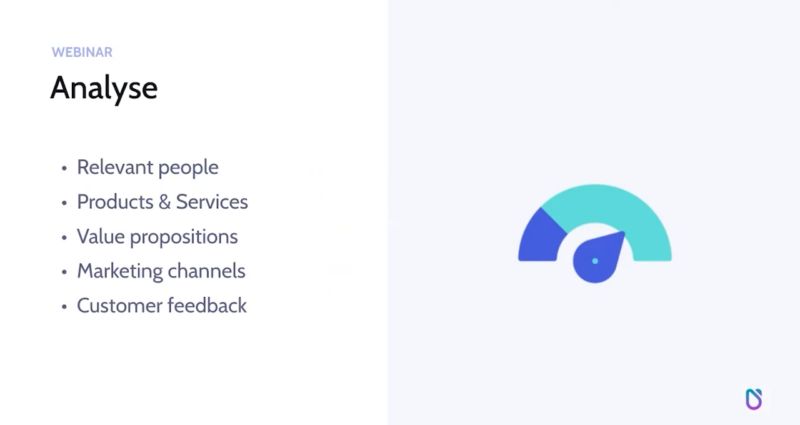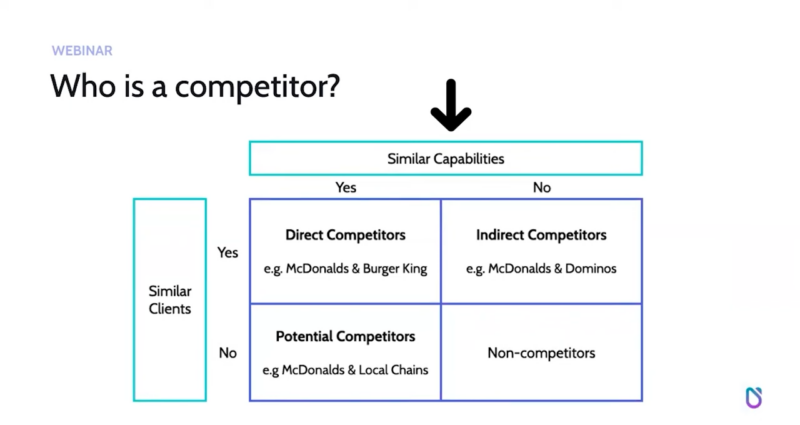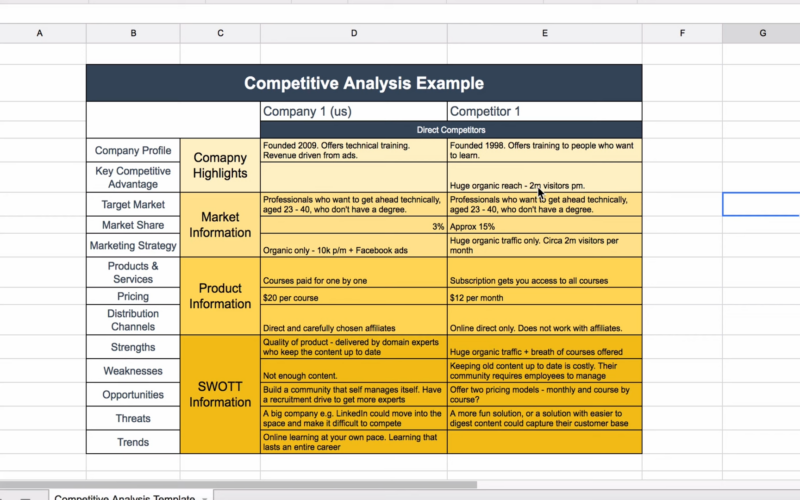We can all agree that we’re living in a fast-paced and hyper-competitive business environment, which is why understanding your competition is a necessity. Imagine launching a product or service into the market without knowing what your competitors are offering. It’s akin to setting sail without a map, hoping the winds will carry you to your destination.
The reality is, you could end up lost at sea, or worse, sinking without a trace. That’s where competitive analysis comes into play. But what exactly is a competitive analysis, and how can it drive your business forward?
Everything You Need to Know About Competitive Analysis
At its core, competitive analysis is the process of identifying and evaluating your competitors to understand their strengths and weaknesses relative to your own. But it’s not just about knowing who your competitors are; it’s about understanding the entire competitive ecosystem.
This includes analyzing their products, services, marketing strategies, pricing models, customer reviews, and even their company culture. The goal? To find gaps in the market that your business can fill, to anticipate industry trends, and to outmaneuver your competition.
How to Conduct a Competitive Analysis
Conducting a competitive analysis might seem daunting, but it can be broken down into manageable steps. Let’s walk through the process:
1. Identify Your Competitors
Before you can analyze your competitors, you need to know who they are. Competitors can be direct or indirect:
- Direct Competitors: These are businesses that offer the same or similar products or services as you. For example, Coca-Cola and Pepsi are direct competitors.
- Indirect Competitors: These are businesses that don’t offer the same product but could satisfy the same customer need. For example, a movie theater and a streaming service like Netflix could be considered indirect competitors because they both compete for the same entertainment dollar.
Start by listing all the companies that you believe are your competitors. Don’t forget to include new entrants to the market and those operating in adjacent industries.
2. Gather Data on Your Competitors
Once you’ve identified your competitors, it’s time to gather data. This is where you’ll need to put on your detective’s hat. Here’s what you should be looking for:
- Products and Services: What products or services do they offer? What are their key features? How do they compare to yours in terms of quality, price, and customer satisfaction?
- Pricing Strategy: What are their pricing models? Are they offering discounts, bundles, or loyalty programs? How do their prices compare to yours?
- Marketing Strategy: Go with Market analysis. How are they marketing their products? What channels are they using (social media, email, SEO, etc.)? What is their brand message? Are they focusing on specific customer segments?
- Customer Reviews and Feedback: What are customers saying about them? Look at reviews on platforms like Yelp, Google, or specialized forums. What are the common praises or complaints?
- Social Media Presence: How active are they on social media? What’s their engagement like? What kind of content do they post?
- SWOT Analysis: Conduct a SWOT (Strengths, Weaknesses, Opportunities, Threats) analysis on each competitor. This helps you understand where they excel, where they falter, and how external factors might affect them.
3. Analyze the Data
Now that you’ve gathered all this data, it’s time to make sense of it. This step involves comparing your business to your competitors across various metrics. Here’s what to focus on:
- Strengths and Weaknesses: Identify areas where your competitors excel and where they’re lacking. This could be anything from product features to customer service. Compare these to your own strengths and weaknesses.
- Market Positioning: How are your competitors positioning themselves in the market? Are they going for a premium market, or are they targeting budget-conscious customers? How does your positioning compare?
- Customer Satisfaction: Are your competitors keeping their customers happy? How do their customer satisfaction levels compare to yours? Are there gaps in their customer service that you can exploit?
- Innovation: Are your competitors innovating? Are they introducing new products or features? How does your innovation stack up?
4. Identify Opportunities and Threats
With your analysis in hand, you can now identify opportunities and threats:
- Opportunities: Look for gaps in the market that your competitors aren’t filling. This could be a customer need they’re not addressing or a market segment they’re ignoring. Also, consider how you can improve your offerings based on what you’ve learned.
- Threats: Identify any threats that your competitors pose to your business. This could be a new product launch, a price drop, or an aggressive marketing campaign. Develop strategies to mitigate these threats.
5. Develop Your Competitive Strategy
The final step is to develop a competitive strategy based on your analysis. This strategy should help you leverage your strengths, exploit your competitors’ weaknesses, and position your business for success. Here are some tactics to consider:
- Differentiation: Focus on what makes your product or service unique. This could be superior quality, better customer service, or a more innovative approach. Make sure your customers understand what sets you apart.
- Cost Leadership: If you can’t beat your competitors on features, consider competing on price. However, be cautious with this approach as it can lead to a price war, which might hurt your margins.
- Focus Strategy: Rather than trying to compete in the entire market, focus on a specific niche where you can be the leader. This could be a particular geographic area, a customer segment, or a product category.
- Partnerships and Alliances: Consider forming partnerships with other businesses to strengthen your market position. This could be a strategic alliance with a complementary business or a joint venture to enter a new market.
- Innovation: Stay ahead of the competition by continually innovating. This could involve improving your product, developing new features, or finding more efficient ways to serve your customers.
Which Tools and Techniques Are Used?
Competitive analysis doesn’t have to be a manual process. There are numerous tools available to help you gather and analyze data more efficiently.
1. SWOT Analysis
A tried-and-true method, SWOT analysis involves listing your competitors’ strengths, weaknesses, opportunities, and threats. It’s a simple but effective way to get a snapshot of your competition’s position in the market.
2. Porter’s Five Forces
This model, developed by Michael Porter, helps you analyze the competitive forces in your industry. It looks at five key factors: the threat of new entrants, the bargaining power of suppliers, the bargaining power of buyers, the threat of substitute products or services, and the intensity of competitive rivalry.
3. Benchmarking
Benchmarking involves comparing your business’s performance to that of your competitors across various metrics. This could be anything from sales and marketing effectiveness to customer satisfaction and product quality.
4. PEST Analysis
PEST stands for Political, Economic, Social, and Technological factors. This analysis helps you understand the broader environment in which your competitors operate and how it might affect their business.
5. Social Media Monitoring Tools
Tools like Hootsuite, Sprout Social, and BuzzSumo can help you monitor your competitors’ social media activity. You can see what content they’re posting, how their audience is engaging, and what topics are trending in your industry.
6. SEO Tools
SEO tools like SEMrush, Ahrefs, and Moz can help you analyze your competitors’ online presence. You can see what keywords they’re ranking for, how much traffic they’re getting, and where their backlinks are coming from.
Common Mistakes You Should Avoid
While competitive analysis is a powerful tool, it’s easy to make mistakes that can lead to misguided strategies.
Focusing Too Much on Direct Competitors
While it’s essential to understand your direct competitors, don’t ignore indirect competitors and substitutes. These can often pose a more significant threat, especially if they offer a different approach to solving the same customer problem.
Not Updating Your Analysis Regularly
The competitive landscape is constantly changing, so your analysis needs to be updated regularly. What worked last year might not work today. Make it a habit to review your competitive analysis at least once a quarter.
Ignoring Small Competitors
Small or new competitors might not seem like a threat at first, but they can quickly grow and disrupt the market. Don’t dismiss them just because they’re not a big player yet.
Overestimating Your Competitors
It’s easy to get intimidated by your competitors, but remember that they have weaknesses too. Don’t let their strengths overshadow your own.
Relying Too Much on Public Information
While public information is valuable, it often only tells part of the story. Consider gathering firsthand data through customer surveys, mystery shopping, or industry networking.
In Summary
Don’t let your business sail aimlessly in a sea of competition. Use competitive analysis as your navigational chart, guiding you to success in the ever-changing business landscape. The whole process might be challenging, but with the right insights, you’ll always be one step ahead.
Hey there! I’m Isla Craig. I’ve spent years diving into the ins and outs of the modern workplace, helping people get ahead and feel good about their careers. From boosting productivity to nailing leadership skills and personal growth, I’ve got a bit of experience in it all.
On our website, my mission is simple: give you the tools and tips you need to rock your career and enjoy a balanced life. I’m here to be your go-to source for advice and inspiration, no matter where you are in your professional journey.









